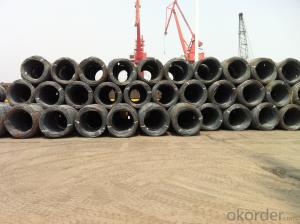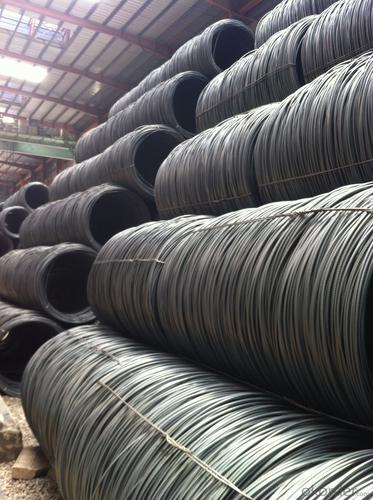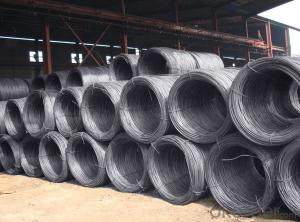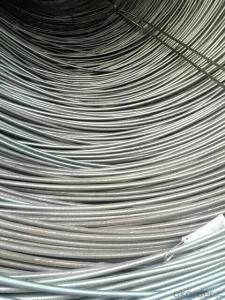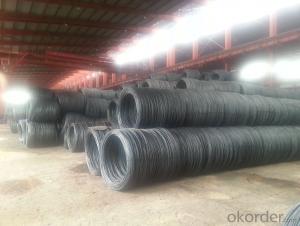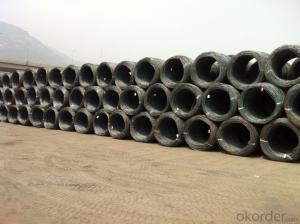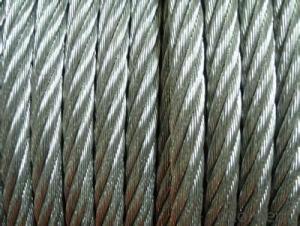Hot Rolled Steel Wire Rods with Best Price in Grade SAE1006-1018
- Loading Port:
- Tianjin
- Payment Terms:
- TT OR LC
- Min Order Qty:
- 25 m.t
- Supply Capability:
- 10000 m.t/month
OKorder Service Pledge
OKorder Financial Service
You Might Also Like
OKorder is offering wire rods at great prices with worldwide shipping. Our supplier is a world-class manufacturer of steel, with our products utilized the world over. OKorder annually supplies products to European, North American and Asian markets. We provide quotations within 24 hours of receiving an inquiry and guarantee competitive prices.
Product Applications:
After hot-rolled the products shaped into coil and delivery as finished product, including round, square,rectangular, hexagonal and so on. Since most of the products are round, it is generally called wire rod. Carbon steel wire rod is widely used in construction and manufacturing. Carbon steel wire rod is mainly used for reinforcement of reinforced concrete and welded structure or reprocessed (roberts , nail, etc.) materials, especially used to produce wire drawing, welding electrode, nails, spring, electronic, precise machinery parts and so on.
Product Advantages:
OKorder's Wire rods are durable, strong, and resist corrosion.
Main Product Features:
· Premium quality
· Prompt delivery & seaworthy packing (30 days after receiving deposit)
· Corrosion resistance
· Can be recycled and reused
· Mill test certification
· Professional Service
· Competitive pricing
Product Specifications:
Manufacture: Hot rolled
Grade: SAE1006-SAE1018
Certificates: ISO, SGS, BV, CIQ
Packaging: Export packing, nude packing, in coils
Grade | Chemical Composition (%) | |||||
C | Mn | S | P | Si | B | |
SAE1008B | 0.10max | 0.32max | 0.045max | 0.040max | 0.30max | 0.0008min |
Mechanical properties | ||||||
Yield strength(N/mm2) | Tensile strength(N/mm2) | Elongation (%) | ||||
≥195 | 350-380 | ≥32 | ||||
FAQ:
Q1: Why buy Materials & Equipment from OKorder.com?
A1: All products offered byOKorder.com are carefully selected from China's most reliable manufacturing enterprises. Through its ISO certifications, OKorder.com adheres to the highest standards and a commitment to supply chain safety and customer satisfaction.
Q2: How do we guarantee the quality of our products?
A2: We have established an advanced quality management system which conducts strict quality tests at every step, from raw materials to the final product. At the same time, we provide extensive follow-up service assurances as required.
Q3: How soon can we receive the product after purchase?
A3: Within three days of placing an order, we will begin production. The specific shipping date is dependent upon international and government factors, but is typically 7 to 10 workdays.
Images:

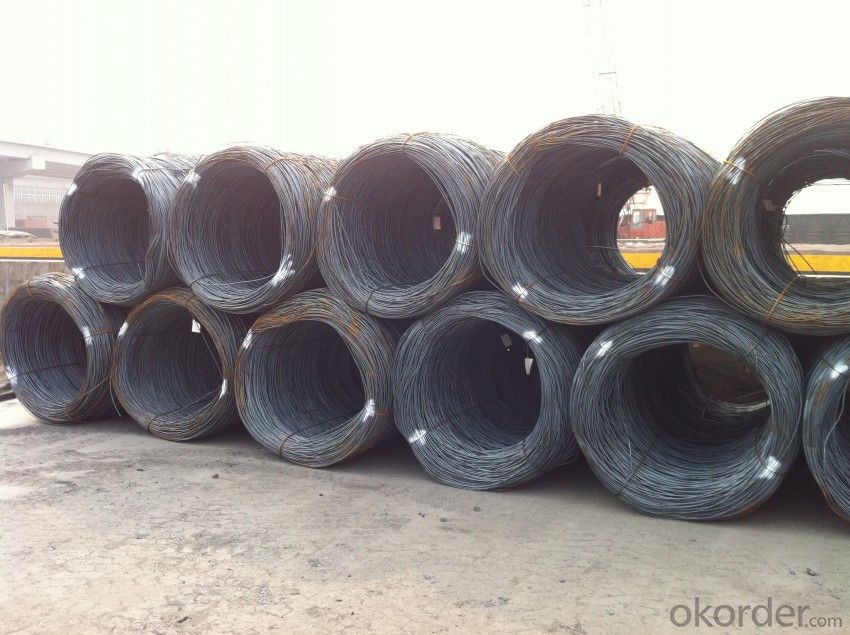
- Q: What are the common finishing methods for steel wire rod?
- The common finishing methods for steel wire rod are drawing, annealing, coating, and galvanizing.
- Q: What are the main distribution channels for steel wire rod?
- The main distribution channels for steel wire rod include direct sales to manufacturers, wholesalers, and distributors.
- Q: How is steel wire rod used in the manufacturing of wire forms for bridge cables?
- The manufacturing of wire forms for bridge cables relies heavily on steel wire rod. This essential component serves as the raw material for producing the wire strands that compose the bridge cables. These strands are then twisted together to form the cables, providing the necessary strength and support for bridges. To transform the steel wire rod into suitable wire strands for bridge cables, it undergoes a series of processes. Initially, the rod is cleaned and descaled to eliminate impurities and contaminants. It is then heated to a specific temperature and passed through dies, which decrease its diameter and increase its length. This process, known as wire drawing, takes place. Following wire drawing, the steel wire rod undergoes further processing via a stranding machine. Multiple wire strands are twisted together in a specific pattern to create a stronger and more durable cable. The twisting process ensures that the individual wire strands are tightly bound together, providing the necessary strength to withstand the load and tension experienced by bridge cables. The quality of the steel wire rod used in the manufacturing process is of utmost importance to ensure the strength and performance of the bridge cables. It must possess the appropriate combination of tensile strength, ductility, and corrosion resistance. High-quality steel wire rod meeting specific standards and specifications is carefully chosen to guarantee the reliability and longevity of the bridge cables. In conclusion, steel wire rod plays a critical role in the manufacturing of wire forms for bridge cables. Through processes such as wire drawing and stranding, it is transformed into wire strands, which are then twisted together to form the cables. The quality of the steel wire rod is vital in ensuring the strength and durability of the bridge cables, making it an indispensable component in the construction and maintenance of bridges.
- Q: How is steel wire rod coated for corrosion protection?
- Steel wire rods are commonly coated for corrosion protection using various methods. One common method is hot-dip galvanizing. In this process, the wire rod is passed through a bath of molten zinc at a temperature of around 450 degrees Celsius. The zinc coating bonds with the surface of the wire rod, providing a protective layer against corrosion. Another method is electroplating, where the wire rod is immersed in an electrolyte solution containing zinc ions. An electric current is then passed through the solution, causing the zinc ions to bond with the surface of the wire rod. This forms a uniform and durable zinc coating that protects against corrosion. Additionally, wire rods can be coated with organic coatings such as paint or polymer coatings. These coatings are applied through processes like spraying, dipping, or electrostatic deposition. The organic coatings create a barrier between the steel wire rod and the surrounding environment, preventing corrosion by blocking moisture and other corrosive agents from reaching the surface. Overall, the coating process used for steel wire rod depends on the specific requirements and intended application. Factors such as the level of corrosion resistance needed, the environmental conditions, and the desired appearance of the wire rod all play a role in determining the appropriate coating method.
- Q: How is the steel wire rod industry regulated?
- The steel wire rod industry is regulated through a combination of government regulations and industry standards. Governments typically set regulations on areas such as product quality, safety standards, environmental impact, and labor practices. These regulations ensure that the industry operates within certain parameters to protect the interests of consumers, workers, and the environment. Additionally, industry standards and certifications are often established by professional associations or organizations to further regulate and ensure the quality and safety of steel wire rod products.
- Q: What are the physical properties of a steel wire rod?
- The physical characteristics of a steel wire rod encompass its size, strength, toughness, pliability, and electrical conductivity. Size: Steel wire rods are available in a range of sizes and diameters, typically spanning from 5.5mm to 20mm. The length of the rod can vary depending on the manufacturer and intended use. Strength: Steel wire rods are renowned for their exceptional tensile strength, allowing them to withstand substantial loads and tension without fracturing or distorting. This strength is a product of the steel's composition and the manufacturing procedure. Toughness: Steel wire rods possess a specific level of toughness, which pertains to their resistance against indentation or scratching. The rod's hardness can be influenced by the type of steel alloy employed and any heat treatment methods employed during manufacturing. Pliability: Steel wire rods are recognized for their remarkable pliability and capacity to bend without breaking. This pliability stems from the inherent ductility of the steel material, enabling the rod to be shaped and employed in a variety of applications, including construction, automotive, and electrical industries. Electrical Conductivity: Steel wire rods exhibit excellent electrical conductivity, rendering them suitable for applications requiring the transmission of electrical energy or signals. However, it is crucial to note that steel is not as conductive as other metals such as copper or aluminum. In conclusion, steel wire rods are highly valued for their amalgamation of strength, toughness, pliability, and electrical conductivity, which renders them versatile and extensively utilized across various industries and applications.
- Q: What are the different types of steel wire rod coatings used for increased strength?
- There are several different types of steel wire rod coatings that are commonly used to increase strength. These coatings are applied to the surface of the wire rod to enhance its mechanical properties and improve its overall performance. One common type of coating used for increased strength is zinc coating. Zinc coating, also known as galvanizing, involves immersing the wire rod in a bath of molten zinc. This process forms a protective layer of zinc on the surface of the wire rod, which provides excellent corrosion resistance. The zinc coating also acts as a barrier, preventing the wire rod from coming into direct contact with corrosive substances, thus increasing its strength and durability. Another type of coating used for increased strength is polymer coating. Polymer coatings are applied to the wire rod through various methods such as extrusion or electrostatic spraying. These coatings form a protective layer that offers resistance to abrasion, impact, and corrosion. Polymer coatings can also improve the wire rod's flexibility and resistance to fatigue, thereby increasing its overall strength. Additionally, epoxy coatings are commonly used for increased strength. Epoxy coatings, which consist of a mixture of resin and hardener, are applied to the wire rod's surface through a process called electrostatic deposition. These coatings provide excellent adhesion and chemical resistance, making the wire rod stronger and more resistant to corrosion. Furthermore, ceramic coatings are used to increase the strength of steel wire rods. Ceramic coatings are typically applied through thermal spraying techniques, where a ceramic material is heated and propelled onto the wire rod's surface. These coatings offer exceptional hardness, wear resistance, and high-temperature resistance, making the wire rod more robust and suitable for demanding applications. In summary, the different types of steel wire rod coatings used for increased strength include zinc coating, polymer coating, epoxy coating, and ceramic coating. Each of these coatings provides distinct advantages in terms of corrosion resistance, flexibility, adhesion, and wear resistance, ultimately enhancing the strength and durability of the wire rod.
- Q: How is steel wire rod used in the production of wire hangers?
- Steel wire rod is used in the production of wire hangers as it serves as the primary raw material for manufacturing the hanger's frame. The wire rod is first processed through various shaping and cutting techniques to form the desired hanger shape. It provides the necessary strength and durability to support the weight of clothing while ensuring a sturdy and reliable structure.
- Q: How is steel wire rod used in the manufacturing of wire displays?
- Steel wire rod is used in the manufacturing of wire displays as it serves as the primary material for creating the intricate wire structures and frames. The wire rod is cut, shaped, and welded to form the desired display designs, providing strength and stability to hold various products or items. Additionally, the steel wire rod can be coated or painted to enhance durability and aesthetics, ensuring that the wire displays are both functional and visually appealing.
- Q: How is steel wire rod tested for resistance to crevice corrosion?
- Steel wire rod is tested for resistance to crevice corrosion through various methods, including visual inspection, weight loss measurement, electrochemical testing, and exposure to corrosive environments. These tests help determine the susceptibility of the steel wire rod to crevice corrosion, which is crucial for ensuring its durability and performance in different applications.
Send your message to us
Hot Rolled Steel Wire Rods with Best Price in Grade SAE1006-1018
- Loading Port:
- Tianjin
- Payment Terms:
- TT OR LC
- Min Order Qty:
- 25 m.t
- Supply Capability:
- 10000 m.t/month
OKorder Service Pledge
OKorder Financial Service
Similar products
Hot products
Hot Searches
Related keywords


